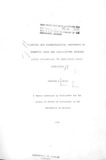| dc.description.abstract | A high incidence of clinical and subclinical canine
ehrlichiosis was found in dogs from Nairobi and the surrounding
area, using a modification of an established blood mononuclear
cell culture test. Clinical signs observed included pyrexia,
depression, selective appetite, weight loss, splenomegaly,
lymphadenopathy, epistaxis, haematemesis, haematuria, blood in
faeces and haemorrhages in the skin and mucous membranes.
Bleeding into joints and the spinal column, reduced conception
rates and abortions also appeared to be associated with the
presence of Ehrlichia canis. The frequency of these signs and
corresponding changes in the blood were studied in 373 domestic
dogs and 16 silver-backed jackals. The cases were grouped
according to the major presenting signs and individual clinical
cases representing the characteristics of most groups have been
described. There was no difference in the clinical disease
seen in pure-bred dogs~ German Shepherd dogs or cross-bred dogs.
Eight cross-bred puppies were experimentally infected with
E. canis and the disease reactions were studied. The clinical
and haematological changes were mild and transient in all but
one of these dogs. These changes, though mild, were similar to
*(exluding German Shepherd dogs)
those presented by naturally occurring cases seen at the clinic.
One of these eight dogs however, died after becoming severely
pancytopenic. On post-mortem examination, extensive
haemorrhages were found throughout the carcase and histologically
plasma cell infiltration was evident in most organs. These
findings were typical of the disease as described elsewhere in
the world.
Tetracycline hydrochloride, doxycycline and imidocarb
dipropionate were evaluated for their efficacy in the treatment
of the clinical disease and for their ability in the elimination
of the causative organism from the peripheral blood. All three
drugs were effective in treating the clinical disease, but
imidocarb dipropionate was the most efficient in eliminating
the organism from the peripheral blood. The use of imidocarb
dipropionate was associated with a number of undesirable side
effects which have been documented. The responses of 153 of
these clinical cases to treatment with these compounds were
followed in detail.
Free-living jackals were shown to harbour E. canis using
the blood mononuclear test. Ehrlichia canis from jackals was
cultured and subinoculated into young cross-bred puppies.
Clinical and haematological changes in these puppies indicated
a disease process that was similar to that seen in the
experimentally infected puppies and in many of the naturally
occurring cases. Rhipicephalus sanguineus and Haemaphysalis
leachii, which are common ticks on domestic dogs, were among
the tick species carried by these infected jackals and
R. sanguine us is the known vector of ehrlichiosis. Tick-sharing
could occur where dogs and jackals intermingle and it is likely
that free-living jackals could act as a natural reservoir for
ehrlichiosis in Kenya. | en |

